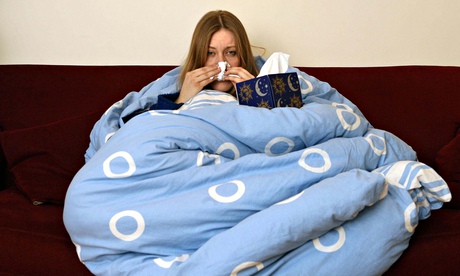
The number of working days lost to sickness fell to 131m in 2013, and was down by a more than a quarter on the figure recorded in 1993, official figures show.
However, although the number of sick days taken is generally falling, more working days were lost to stress and depression.
The Office for National Statistics said the average worker took 4.4 days off in 2013 due to sickness, compared with 7.2 days in 1993. Over the same period the total number of days lost has fallen from 178m.
Although concerns about job loss during the recession may have prompted some people to go into work rather than calling in sick, the number of days taken off was falling in the runup to the financial crisis. The ONS said most of the fall in sickness absence took place between 2003 and 2011.
The main cause for working days lost in 2013 was musculoskeletal conditions such as back and neck pain, which led to 31m days off, while minor illnesses such as coughs and colds resulted in 27m days sick. Stress, anxiety and depression were the cause of 15m absence days, up from 11.8m in 2010.
Dr John Philpott, director of The Jobs Economist, said the scale of mental health issues could be even higher, though disguised by employees giving other reasons for their absence.
"While common mental health problems account for only 8% of all working days lost to sickness absence, the disturbing upward trend indicates that the UK workforce is becoming increasingly stressed out, with pressure from bosses to get the job done ever more intense at a time when falling real wages mean most workers are struggling to make ends meet," he said.
"Critics are wrong to dismiss such absence as merely symptomatic of a 'sickie culture' and should instead direct their attention to the excessively controlling management practices and insecure labour market conditions, such as the rising incidence of zero-hours contracts, that are causing increasing numbers of workers to crack under the strain."
The ONS figures showed that men had a lower absence rate than women, losing 1.6% of their hours to sickness in 2013, compared with 2.6% among women.
"Women and men work in different types of jobs and when controlling for these differences and other factors that influence sickness, women were 42% more likely to have a spell of sickness than men," the ONS said
The ONS also compared the self-employed with employees and found that while those in employment lost 2.1% of their working hours to sickness, among those working for themselves the figure was just 1.2%.
The percentage of hours lost to sickness in the private sector was lower than in the public sector, at 1.8% and 2.9% respectively. Sickness rates were higher for those working in a health authority or NHS trust
(3.4%), followed by those in central government (3%).
The ONS said: "When controlling for the different factors that influence sickness, public sector workers were 24% more likely to be off work due to sickness than those in the private sector."

